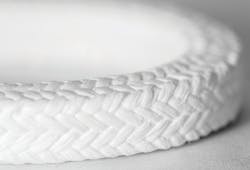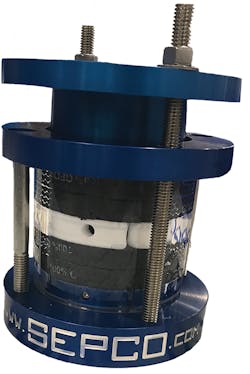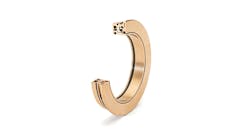Safe, effective food and beverage seal technology
Sanitation is required in the food and beverage industry. Perhaps the only industry that may be more stringent is the pharmaceutical and life sciences industry. When sealing equipment, however, safety and housekeeping issues may be difficult to prevent. When product leaks from a pump, valve, mixer, blender, agitator, evaporator, hot oil system or lubrication system, risks and other problems arise. Some examples are:
- Product loss and associated costs
- Maintenance issues and part replacements (including new seal technology)
- Downtime to replace/maintain equipment
- Slip risks as product leaks on the floor
- Housekeeping problems on the floor and on other equipment
- Bacteria growth on assets that leak
Installing seal technology that fits the process and provides safety for personnel and equipment is critical. Different seal types to consider are:
- Packing
- Mechanical seals
- Air seals
- Bearing/lubrication seals
- Packing
Compression packing is one of the oldest and most common technologies. A gland along the top packing ring is tightened, and the packing is compressed into the stuffing box. Packing is constructed of relatively soft materials that are inserted as cut rings between the rotating member and the body of the pump casing, valve or other asset. The tightened gland against the outboard ring transmits pressure evenly to the entire packing set if installed correctly (see Image 1). This pressure expands the rings radially, creating a seal.
When selecting packing for pumps and valves, polytetrafluoroethylene (PTFE), shown in Image 2, is an ideal choice. It is resistant to high temperatures, and the fibers are FDA compliant. PTFE packing is white, which prevents any color transfer to the product being processed. The lubricant added to the packing rings must also be FDA compliant and avoid color transfer in color-sensitive applications.
Packing performs well in applications in which a small amount of flush water leakage is permittable because packing must leak. If leakage is not possible, a different seal type should be considered, such as a mechanical seal.
Mechanical seals
Installed within the seal chamber or stuffing box of pumps, mechanical seals are an ideal selection when a process cannot leak. The solids content of the process should be removable with an external flush system. This technology consists of two flat faces, one rotating and one stationary.
Mounted perpendicular to the shaft, the rotary seal ring’s rotation against the stationary seat ring causes a rapid pressure drop across the primary seal interface caused by friction on the liquid molecules between the seal faces. These liquid molecules also act as small ball bearings to lubricate and reduce friction, which reduces heat and wear.
As with the packing decision, the needs of the application must be considered when choosing a mechanical seal type. The factors that affect seal reliability and must be considered when selecting a seal are:
- Application
- Installation
- Operation
In this industry, the mechanical seal must be FDA compliant. The material of construction must also be compatible with the pH of the pumped fluid. Care should also be taken when applying flush water, particularly if adding water to the process adds costs or affects the product. Mechanical seals must be adequately flushed to remove heat and keep the seal faces clean and lubricated.
Air seals
Air seals, a type of mechanical seal, are discussed separately because they are primarily used when managing powders or thick slurries. Air seals are primarily installed on:
- Mixers
- Agitators
- Screw conveyors
- Rotary airlocks
This technology effectively contains product when packing or a traditional mechanical seal fails to seal correctly or damages the shaft because product interacts with the seals. As the name indicates, air seals use air, not flush water. They do not contact the shaft. Their non-contact nature prevents shaft/sleeve wear that may occur with packing or mechanical seals. This is especially true when the powder or slurry material enters the seal technology.
Air seals use engineered clearances and directional flow paths to create uniform pressure and velocity profiles. A boundary layer of air is formed between the throttle and the shaft/sleeve. This boundary, sometimes called an air knife, mitigates any damage that would occur because of mechanical runout because the throttle floats. The floating throttle withstands ±0.125 inch of parallel movement. Product does not enter the seal technology and will not leak.
This seal has been particularly effective in the chocolate industry in chocolate conches (see Image 3). It also successfully contained the dry and wet ingredients when mixing the dough for animal crackers (see Image 4). When mixers are used, any leakage could cause:
- Housekeeping problems
- Safety and slip risks
- Bacterial growth at leakage sites
- Clogging of or damage to rotating parts
Bearing and lubrication protection
An oil seal or bearing isolator performs two critical tasks. It prevents lubricant from entering the process. It also blocks process fluids and outside moisture to keep them from contaminating the bearings and their lubrication.
If lubrication enters the food process, the batch will be ruined if food-grade lubricants are not used. In addition, food will also contaminate the lubricant and bearings. Neither event will be good for production or for the equipment. Therefore, a bearing isolator must be selected with materials of construction that will perform well in the environment. It must also protect from contaminants during dynamic and static conditions.
Many oil seals keep contaminants out when a pump or other equipment operates. However, when the machine is shut down, moisture enters the bearing housing as the equipment moves toward equilibrium. In some vertically oriented bearing isolators, two static coalescing O-rings break down vapor and direct it into the expeller chamber (see Figure 1). During dynamic operation, centrifugal force adds energy to contaminants and expels them from the internal environment. This type bearing isolator will protect equipment at all times.
Final considerations
While equipment must be protected when operating in any industry, the food and beverage industry presents special challenges. Selecting the best seal technology for each asset in the process protects personnel, equipment and the environment. Thought should be given to:
- The asset being sealed
- The product produced
- The amount of containment required and whether leakage is allowable
- What lubricant is used and if contact with food is permissible
- Whether powder, entrained solids or slurries are involved
Successful product containment and protection will only occur if the ideal seal technology is chosen. Otherwise, equipment downtime, product waste and housekeeping/slip risks will be some of the problems encountered.
Terry Roberts is the Midwest regional manager for Sealing Equipment Products Company (SEPCO). He has worked in the fluid sealing industry for 21 years. In his role with SEPCO, he provides training, sales support and solutions to channel partners and their customers. Roberts is also on the technical committee of the International Sealing Distribution Association.





